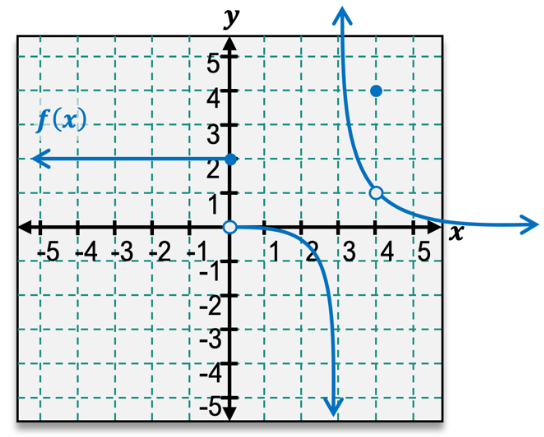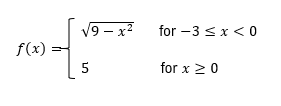Hey, everyone. Here, we're going to talk about continuity. Now we've actually already been dealing with continuity throughout our last several lesson videos. So here, we're really just putting a name to it. See, a function is continuous at some point c if the limit as x approaches c is the same as the function value.
We've seen this happen for quite a few different functions, so we would say that these functions are continuous at those points. Now here, we're going to dive a bit deeper into continuity and also talk about what it means for a function to be discontinuous. So let's go ahead and get started. First, let's take a look at our function on the left here. If we want to find the limit of this function as x approaches 2, I can see that as x gets really, really close to 2 from either side, my function is approaching a y value of 4.
Now if I look at the actual value of my function when x is equal to 2, I see that it's actually the exact same as my limit. It's also 4. So here, my limit is the same as my function value. Now because these two values are the same, this function is continuous at x equals 2. But let's take a look at our other function here.
Again, if I want to find the limit of this function as x approaches 2, I can see that as x gets really, really close to 2 from either side, my function is approaching a y value of 1. Now, as for the actual value of my function when x is 2 here, I see that there's actually a hole on my graph when x is equal to 2. So the value of my function here is actually undefined. So here, my limit is definitely not the same as my function value. I know that this function is discontinuous for x equals 2.
By finding our limit and our function value, we're able to determine continuity using its definition. I also want to give you a visual tool to recognize continuity. If we take a look at our graph and take our pen or pencil and trace through our function, if we can trace through a specified point without stopping, then the function is continuous there. Let me show you exactly what I mean by that. Coming back down to our parabola here, if I trace through my function when x is equal to 2, I can do so smoothly without having to lift my pen.
So I know it's continuous there. But if I come over to my function here and I try to do the same thing trace through my function now if I do that here, I can start tracing, but then I have to stop, pick up my pen, and continue on the other side of 2 because it is discontinuous there. You can think of this as a tool to help you identify problem areas on a function by looking at a graph, but you'll often still need to find your limit and your function value to fully verify continuity. With this function here, it was discontinuous at 2 specifically because there was a hole there. Discontinuities occur whenever a function has a hole but also when a function has either a jump or an asymptote.
Discontinuities happen commonly for rational functions and for piecewise functions, with rational functions often having holes or asymptotes and piecewise functions often having jumps, although they can have other types of discontinuities as well. With all of this in mind, let's go ahead and apply this knowledge to an example problem. In this example, we're asked to determine if the function is continuous for each given value of c by finding both our function value and our limit. We know, if these two values are the same that our function is continuous at that point, Whereas if they are not the same, we know our function is discontinuous there. So let's go ahead and dive into this first value.
Here we have c equals negative 2. Using my sort of visual tracing tool, I can take a look at my graph and see that if I trace along my function when x is equal to negative 2, I don't have to pick up my pen. So I already have an idea that this function is continuous here. But here, we specifically want to verify continuity by using our limit and our function value. So let's go ahead and find that limit.
Now as x gets really, really close to negative 2 from either side, I can see that my function is approaching a y value of 1. Now the value of my function here is actually also 1. So because the limit is the same as my function value, this function is continuous at negative 2. Well, let's move on to our next example here. Here we have c equals 4.
So we first want to find the limit here as x approaches 4. Now as x approaches 4 coming in from that left side, I can see that my function is approaching a value of 1 whereas coming in from the right side we're approaching a value of 3. This limit actually does not exist because my function is not approaching the same value from both sides. Now as for our function value here, I can see that when x is equal to 4, my function value is 1. If my limit does not exist, I can sort of already see that it's going to be discontinuous here, and I can see further that these are not the same; "does not exist" is not the same as 1.
So I know my function is discontinuous here at 4. Looking at this discontinuity specifically, I can see that this is a jump discontinuity because I start on one piece of my function, and I have to jump up to another. Now let's move on to our final example here. Here we have c equals 1. So looking at the limit of our function as x approaches 1, I can see that from either side, my function is going down to negative infinity.
But remember that whenever we have unbounded behavior, our limit does not exist. If we further look at our function value here, our function value is actually undefined because I can see that I have an asymptote here. So I know that this function is discontinuous, specifically caused by our asymptote here. Now that we know what continuity is and how to find it, let's continue practicing. Thanks for watching, and I'll see you in the next one.







